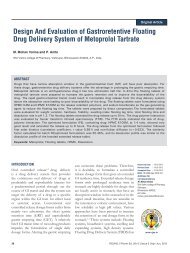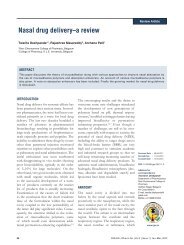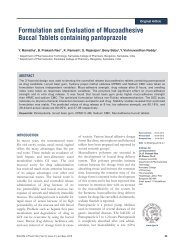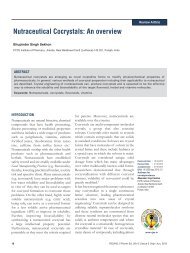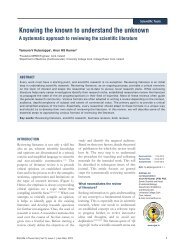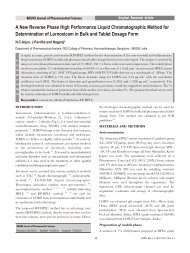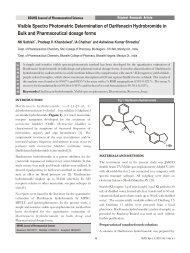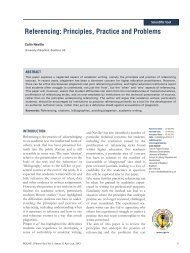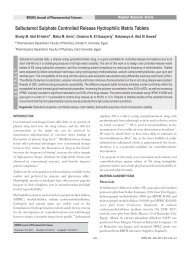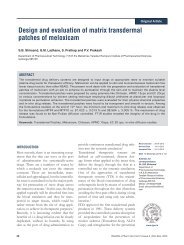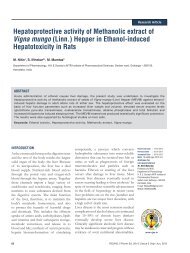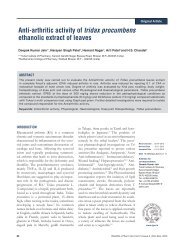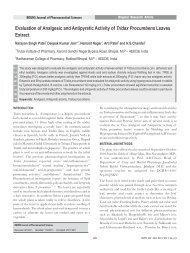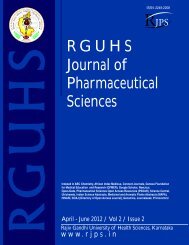Chitosan Loaded Mucoadhesive Microspheres of Gliclazide - Journal
Chitosan Loaded Mucoadhesive Microspheres of Gliclazide - Journal
Chitosan Loaded Mucoadhesive Microspheres of Gliclazide - Journal
You also want an ePaper? Increase the reach of your titles
YUMPU automatically turns print PDFs into web optimized ePapers that Google loves.
RGUHS <strong>Journal</strong> <strong>of</strong> Pharmaceutical Sciences<br />
Creative, Critical Thinking and Logic in Research<br />
Fredricka Reisman<br />
Goodwin College <strong>of</strong> Pr<strong>of</strong>essional Studies, Drexel/Torrance Center for Creativity and Innovation, Drexel University, Philadelphia, PA 19104,<br />
USA<br />
Creative, Critical Thinking and Logic in Research<br />
In order for me, a western mathematics and creativity<br />
researcher and educator, to respond to the exciting invitation<br />
to write an article dealing with creativity for this prestigious<br />
journal published by the Rajiv Gandhi University <strong>of</strong> Health<br />
Sciences, I needed to investigate the essence and focus <strong>of</strong> the<br />
audience. I needed to become familiar with the context in<br />
which my article was to contribute. My investigation led me to<br />
the meanings behind the Emblem <strong>of</strong> the Rajiv Gandhi<br />
University <strong>of</strong> Health Sciences, which to my delight sets the<br />
stage for creative (Human Energy), critical thinking (the<br />
Human Soul) and logic (Knowledge And Enlightenment) as<br />
cornerstones for pharmaceutical research.<br />
The Emblem<br />
The Emblem <strong>of</strong> The Rajiv Gandhi University <strong>of</strong> Health<br />
Sciences is a symbolic expression <strong>of</strong> the confluence <strong>of</strong> both<br />
Eastern and Western Health Sciences. A central wand with<br />
entwined snakes symbolizes Greek and Roman Gods <strong>of</strong><br />
Health called Hermes. Mercury is adapted as symbol <strong>of</strong><br />
modern Medical Science. The pot above the snake depicts<br />
Amrutha Kalasham <strong>of</strong> Dhanvanthri, the father <strong>of</strong> all health<br />
sciences. The wings above it depicts Human Soul called<br />
Hamsa (Swan) in Indian Philosophy. The rising sun at the top<br />
symbolises knowledge and enlightenment. All <strong>of</strong> them set<br />
inside the state map <strong>of</strong> Karnataka. The two twigs <strong>of</strong> leaves in<br />
RGUHS <strong>Journal</strong> <strong>of</strong> Pharmaceutical Sciences<br />
Received: 14/8/2011, Modified: 27/8/2011, Accepted: 28/8/2011<br />
97<br />
Scientific Tools<br />
Western Philosophy symbolizes Olive branches, which is an<br />
expression <strong>of</strong> Peace, Love And Harmony. In Hindu<br />
Philosophy, it depicts the Vanaspathi (also called as Aushadi)<br />
held in the hands <strong>of</strong> Dhanvanthri, which are the source <strong>of</strong> all<br />
medicines. The lamp at the bottom depicts human energy<br />
(Kundalini). The script “Devahitham Yadayahu” inside the<br />
lamp is taken from Upanishath Shanthi Manthram<br />
(Bhadram Karnebhi Shrunuyanadev…) which says “May we<br />
live the full span <strong>of</strong> our lives allotted by God in perfect health”<br />
which is the motto <strong>of</strong> the Rajiv Gandhi University <strong>of</strong> Health<br />
Sciences.<br />
Link to Creative, Critical Thinking and Logic<br />
This link from emblem to reality is assuring that pharmacy<br />
students, faculty and practitioners, in addition to being<br />
excellent learners and researchers, are also creative problem<br />
solvers, first-rate scientists, and effective clinicians. In looking<br />
at the traits <strong>of</strong> highly creative people listed below, we see that<br />
many <strong>of</strong> these traits are salient to creative science researchers<br />
and practitioners in the Pharma industries. In fact, a recent<br />
1<br />
publication considered the question <strong>of</strong> why an<br />
understanding <strong>of</strong> creativity and critical thinking is important<br />
for biomedical scientists, especially those new to their science<br />
career paths.<br />
“Understanding how the big breakthroughs occur can lead the newly<br />
minted scientist to efficiently engage in creative research that results in a<br />
novel, appropriate and useful discovery, to obtain funding support, and<br />
to navigate the publication channel…”<br />
1<br />
F. K. Reisman, 2010<br />
In addition, a recent survey <strong>of</strong> 1,500 chief executives<br />
2<br />
conducted by IBM's Institute for Business Value identified<br />
"creativity" as the most important leadership competency for<br />
corporate success <strong>of</strong> the future. Note that the desired<br />
competency <strong>of</strong> leaders is “creativity----not operational<br />
effectiveness, managerial discipline, influence, or even<br />
dedication.” Until recently, creativity was viewed as an<br />
essential element <strong>of</strong> research or product development, not the<br />
crucial characteristic <strong>of</strong> leadership.<br />
Traits <strong>of</strong> Highly Creative People<br />
Following are traits representative <strong>of</strong> highly creative people<br />
which embody members <strong>of</strong> the pharmaceutical industries<br />
and that form an assessment checklist as shown in Table 1:<br />
Next, in Table 2 are evaluation criteria for assessing creative<br />
RJPS, Jul - Sep, 2011/ Vol 1/ Issue 2



